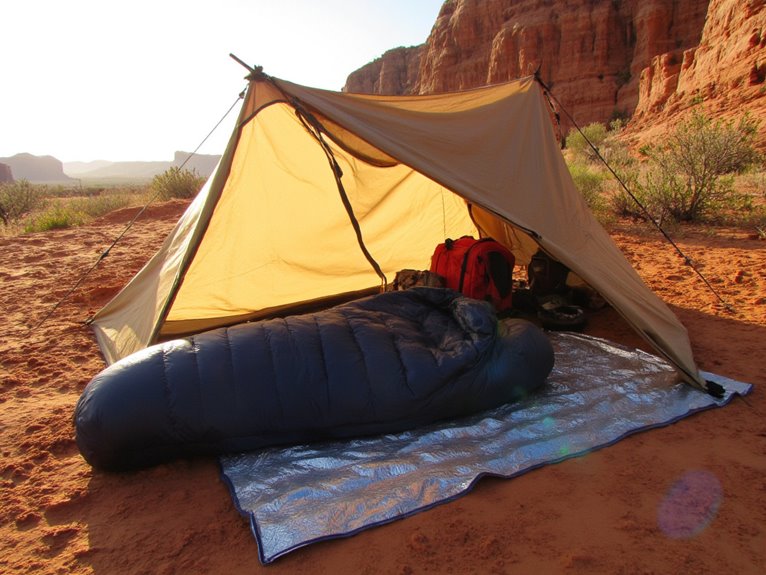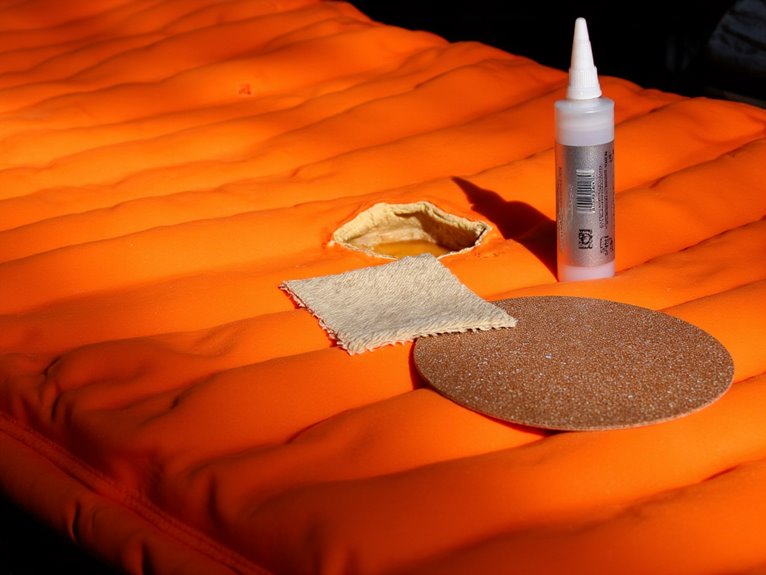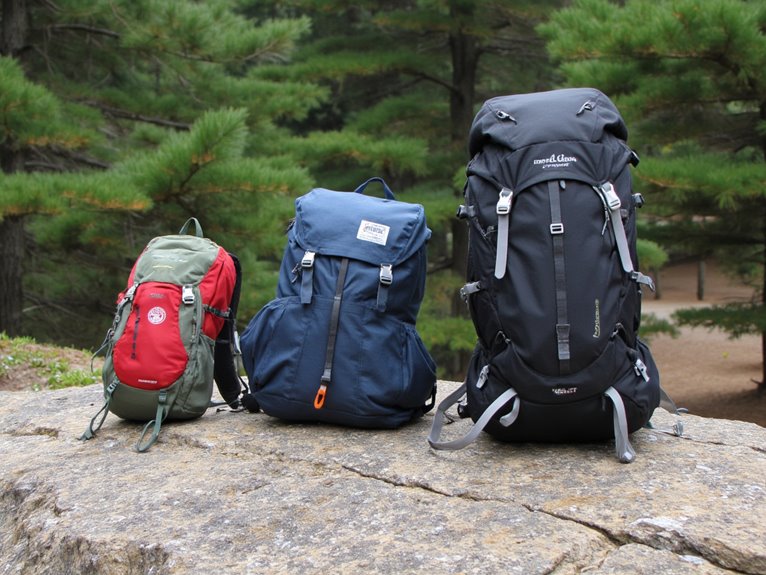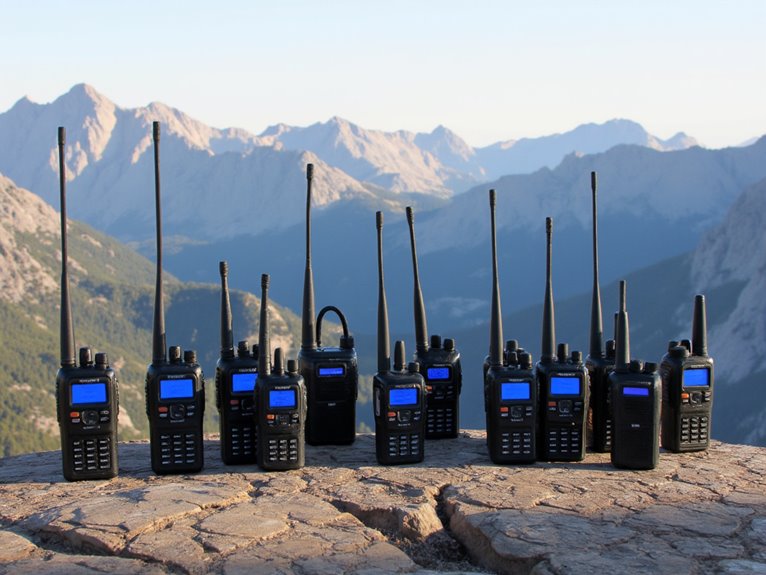Hot Weather Backpacking: Sleep System Strategies to Stay Cool
You’ll sleep cooler by choosing sleeping pads with R-values below 2.0 and switching to ultralight quilts instead of traditional sleeping bags. Air pads and closed-cell foam options under two inches thick maximize ground cooling and airflow. Quilts like the Rock Front 200 Pro offer superior ventilation through open-sided designs, while silk liners weighing just 120 grams provide breathable alternatives. Position your sleep system perpendicular to prevailing winds and use two-way zippers for precise temperature control throughout the night.
We are supported by our audience. When you purchase through links on our site, we may earn an affiliate commission, at no extra cost for you. Learn more. Last update on 10th December 2025 / Images from Amazon Product Advertising API.
Notable Insights
- Choose sleeping pads with R-values below 2 and air pads or closed-cell foam for maximum breathability and airflow.
- Use ultralight quilts with open-sided designs instead of traditional sleeping bags for superior ventilation and temperature control.
- Select silk liners weighing around 120 grams as breathable alternatives to heavy sleeping bags in warm conditions.
- Position sleep systems perpendicular to prevailing winds and use dual-directional zippers for optimal airflow management.
- Camp at higher elevations and in shaded areas to take advantage of natural temperature drops and cooling effects.
Choosing the Right Sleeping Pad for Hot Climates
When backpacking in hot climates, selecting the right sleeping pad becomes critical for maintaining comfort and sleep quality throughout the night.
You’ll want to prioritize pads with R-values below 2 to minimize heat retention. Air pads offer excellent breathability but suffer from air pad disadvantages like potential punctures in harsh terrain.
Foam pad advantages include superior durability and consistent ventilation without puncture risk. Closed-cell foam pads like the Therm-a-Rest Z-Lite provide reliable performance in extreme conditions.
Target thickness around 1-2 inches for ideal airflow. Ultralight options such as the NeoAir XLite NXT at 13 ounces deliver minimal thermal resistance.
Avoid heavily insulated models designed for cold weather, as they’ll trap body heat and cause overheating during warm nights. Consider ultralight options like those weighing less than one pound, which provide minimal thermal mass while still offering cushioning against rocky surfaces.
Selecting Lightweight Sleep Systems and Bag Alternatives
When summer temperatures soar, you’ll need sleep systems that prioritize weight reduction and heat management over maximum insulation.
Ultralight quilts like the Rock Front 200 Pro at 365 grams offer superior ventilation compared to traditional sleeping bags, while silk liners provide breathable comfort that prevents overheating in humid conditions.
These alternatives let you shed significant pack weight while maintaining the airflow essential for comfortable sleep in hot climates.
For optimal portability, look for options that compress into compression sacks reducing packed size by up to 40% to water bottle dimensions for compact transport.
Ultralight Summer Bag Options
Ultralight sleeping systems transform summer backpacking by cutting pack weight without sacrificing comfort during warm-weather adventures. Down-filled bags excel with weights around 1-1.3 pounds, featuring RDS-certified fill and strategic baffle designs. Synthetic alternatives offer superior moisture resistance for humid conditions while maintaining competitive weights.
| Fill Type | Weight Range | Best Conditions | Moisture Performance | Packability |
|---|---|---|---|---|
| Down | 1.0-1.3 lbs | Dry environments | Poor when wet | Excellent |
| Synthetic | 1.2-1.8 lbs | Humid/wet conditions | Excellent | Good |
| Hybrid | 1.1-1.5 lbs | Variable climates | Very good | Very good |
Modern ventilation strategies include partial-length zippers and removable hoods for enhanced temperature regulation. Many bags convert to quilt configurations, improving airflow on hot nights. Compression sacks reduce bulk to sub-1-liter volumes, maximizing pack space efficiency.
Quilt Systems for Ventilation
How do you maximize airflow while maintaining warmth control in your sleep system? Quilts offer superior ventilation compared to traditional sleeping bags through their open-sided design and adjustable features.
Quilt insulation performs differently than bag insulation due to unrestricted airflow. You can fully open quilts during hot weather for maximum cooling, then adjust closure systems when temperatures drop.
Draft collars with snap or drawstring systems provide precise heat regulation around your neck and shoulders without restricting ventilation.
Attachment loops secure quilts to sleeping pads while maintaining side airflow. Partial zippers with drawstring cinches offer moderate ventilation control, though sewn footboxes reduce drafts in cooler conditions.
Ultralight options like 7d ripstop shells weigh 10-20 ounces while providing excellent temperature modularity for varying conditions.
Liner Alternatives for Heat
Beyond quilts, specialized liner systems and alternative sleep configurations can eliminate the need for traditional sleeping bags entirely in warm conditions. Silk liners weigh as little as 120 grams while providing excellent breathability and moisture-wicking properties. You’ll find them ideal for standalone summer use when temperatures remain above 65°F.
Synthetic liners offer similar weight savings with enhanced durability and antimicrobial properties, though they’re less comfortable than silk options.
Hammocks with insect screens maximize airflow while protecting against bugs. Lightweight fleece blankets provide minimal insulation but retain versatility for layering. Inflatable mats with low R-values (0.7-1.0) prevent overheating from ground insulation.
These systems work best when nighttime temperatures stay consistently warm and weather conditions remain stable throughout your trip.
Maximizing Airflow and Ventilation While Sleeping
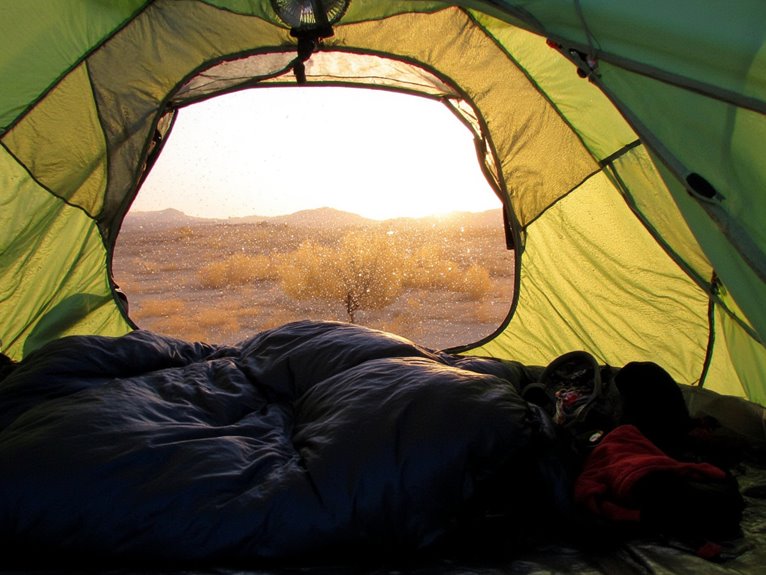
When temperatures soar during summer backpacking trips, proper ventilation becomes critical for maintaining comfortable sleep and preventing dangerous overheating. Your sleep system’s airflow capacity directly impacts core temperature regulation and sweat evaporation rates.
Select sleeping bags featuring breathable materials like mesh panels and dual-directional zippers. These designs increase air circulation by 40-60% compared to standard bags. Quilts offer superior ventilation flexibility, allowing targeted coverage adjustments throughout the night.
Choose sleeping pads with R-values below 2.0 for warm conditions. Lower insulation ratings promote ground cooling while maintaining comfort. Inflatable pads typically provide better airflow than closed-cell foam alternatives. Air pads provide superior comfort and pack down small, making them ideal for hot weather backpacking when weight and ventilation are priorities.
Position your sleep system perpendicular to prevailing winds when possible. Make nighttime adjustments by opening foot-end zippers first, then progressively increasing ventilation as needed. This systematic approach prevents rapid temperature fluctuations while maintaining ideal comfort levels.
Essential Insect Protection for Summer Camping
Your sleep system’s insect protection forms the foundation of comfortable summer camping, requiring two critical components that work together to create an effective barrier.
Bug net integration provides immediate physical protection around your sleeping area, while permethrin treatment offers chemical defense that lasts through multiple wash cycles and up to two weeks of field use.
These complementary strategies guarantee you’ll maintain restful sleep even during peak mosquito activity at dawn and dusk when insects are most aggressive.
Bug Net Integration
Effective insect protection transforms summer backpacking from a miserable swatting experience into comfortable outdoor rest.
Your choice of bug net materials directly impacts performance and durability. Fine mesh super-fine nylon balances breathability with protection, while no-see-um rated mesh blocks tiny biting insects through smaller holes.
Integration techniques determine your system’s effectiveness:
- Built-in hammock nets use structural ridgelines and spreader bars for full enclosure
- Standalone nets attach to ridge lines with drawcord tighteners around hammock ends
- Tent integration requires complete door coverage with zippers or overlapping flaps
- Tarp suspension involves hanging nets inside shelter interiors
Proper setup guarantees taut, securely fastened netting prevents sagging that allows insect contact.
Mesh rip resistance remains critical since tiny tears invite immediate mosquito entry.
Permethrin Treatment Benefits
Although physical barriers like bug nets provide excellent protection, chemical treatment of your gear creates an additional defense layer that eliminates insects on contact.
Permethrin effectiveness reaches over 96% protection against mosquitoes and ticks for up to nine months under weathering conditions. This synthetic pyrethroid bonds to fabric fibers, maintaining insect repellency through six weeks or six washings.
Permethrin-treated tents demonstrate a 58.6% mosquito knockdown rate, considerably outperforming untreated alternatives. Users wearing treated footwear experience 73.6 times fewer tick bites compared to untreated gear.
The chemical provides broad-spectrum protection against 55+ insect species while remaining odorless and stain-free after application.
Apply using slow sweeping motions from 6-8 inches away, using 4.5 ounces per complete outfit for ideal coverage and protection.
Managing Nighttime Temperature Fluctuations
When nighttime temperatures drop unexpectedly during backpacking trips, your sleep system’s adaptability becomes the difference between restful sleep and a miserable night outdoors.
Temperature awareness starts with checking local weather patterns and elevation data before departure. Your camping location directly affects nighttime cooling—higher elevations can drop 3-5°F per 1,000 feet gained.
Key strategies for managing temperature fluctuations:
- Select sleeping bags with two-way zippers for instant ventilation control
- Position tents to capture natural breezes while avoiding wind exposure
- Use moisture-wicking base layers to prevent heat retention
- Choose lightweight sleeping pads that allow better heat dispersion
Proper ventilation through adjustable tent vents maintains airflow without sacrificing weather protection.
Hydration supports your body’s natural temperature regulation mechanisms throughout the night.
Even during hot weather backpacking, selecting sleeping pads with appropriate R-values ensures protection against unexpected ground cooling and maintains thermal comfort.
Cooling Techniques and Comfort Strategies
Beyond regulating your sleep system for unexpected drops, maintaining comfort during sweltering daytime conditions requires a different approach focused on active heat dissipation and strategic fabric choices.
Light-colored clothing reflects solar radiation while loose-fitting garments promote airflow around your body. Choose cooling fabrics like lightweight cotton or synthetic blends that enhance sweat evaporation. Wet your hat or bandana frequently to create evaporative cooling zones around your head and neck.
Effective moisture management starts with strategic water application. Apply water to pulse points at your wrists and neck where blood vessels run close to the surface. Keep your hair damp when possible.
Target pulse points with water for instant cooling—wrists and neck areas where blood flows closest to skin surface.
Move deliberately to generate air currents that accelerate evaporation. Maintain hydration levels to support your body’s natural sweating mechanism throughout extended exposure periods.
Optimal Campsite Selection for Temperature Control
Strategic campsite selection serves as your primary defense against extreme temperatures, often determining whether you’ll sleep comfortably or endure a miserable night of heat stress.
Campsite elevation changes of just 1,000 feet can reduce ambient temperatures by 3-5°F. Natural windbreaks like rock formations and dense vegetation provide vital thermal protection while maintaining airflow.
Consider these essential factors when choosing your site:
- Shade positioning: Select areas with afternoon shade coverage to prevent peak-hour heat exposure.
- Water proximity: Camp 200+ feet from water sources to benefit from evaporative cooling effects.
- Airflow patterns: Identify moderate cross-ventilation zones that dissipate heat without excessive wind exposure.
- Ground composition: Avoid heat-radiating surfaces like rock slabs that increase nighttime temperatures.
Dense canopy coverage reduces solar radiation by up to 90%, creating considerably cooler microclimates for ideal sleep conditions.

